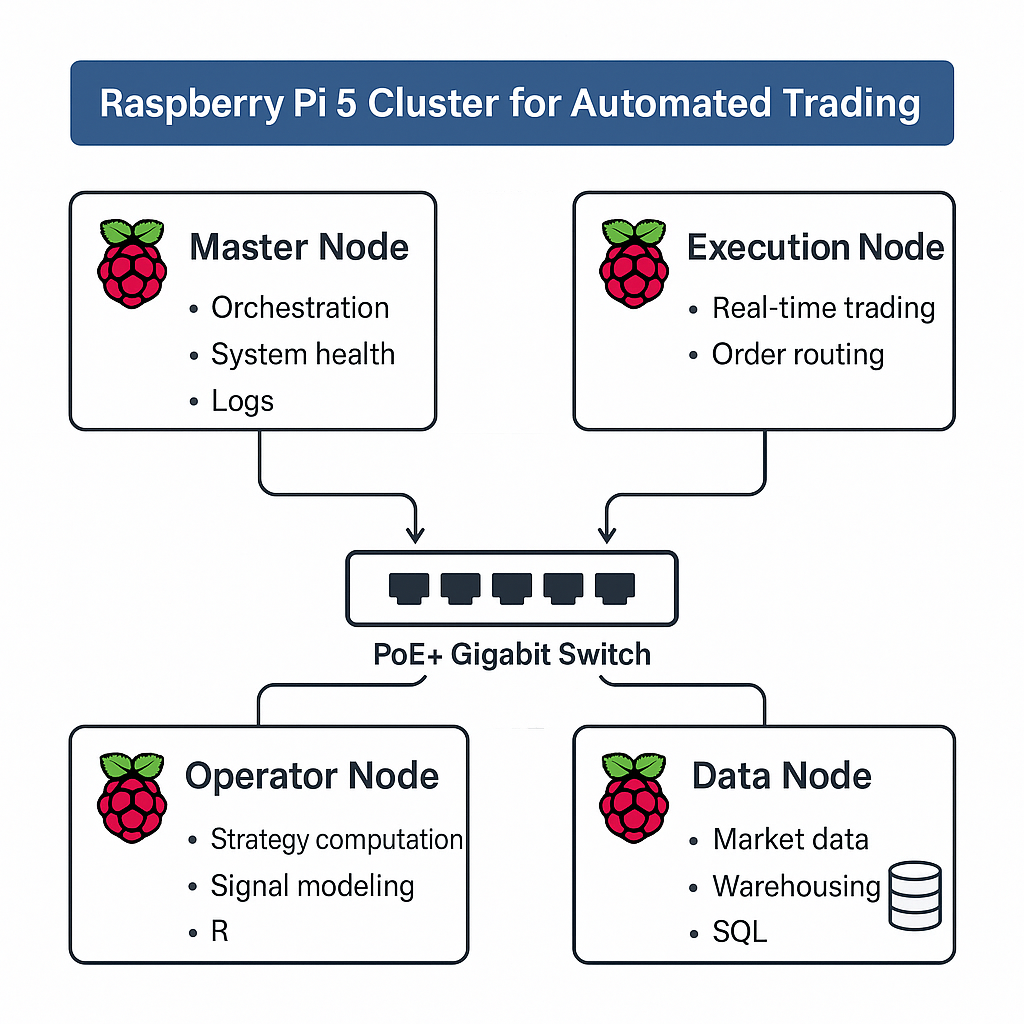Building a Raspberry Pi 5 Cluster for Automated Trading
If you’re like me and you want complete control over your financial systems, value autonomy over institutional dependencies, and enjoy engineering your own tools — building a Raspberry Pi 5 cluster for automated trading is one of the most rewarding setups you can pursue. This guide is specifically for creating a portable, low-power, highly efficient trading infrastructure using C++ for execution, R for signal modeling, SQL for data management, and Ubuntu Server for maximum performance.
🧠 System Overview
This is a modular 4-node cluster built for full-stack trading operations:

- Master Node – Orchestration and system health
- Execution Node – Real-time trading and order routing
- Operator Node – Strategy computation and signal modeling
- Data Node – Market data scraping, warehousing, and archival
All nodes are connected via a Gigabit PoE+ switch for high-speed, full-duplex communication and centralized power.
🧱 Hardware Requirements
| Component | Details |
|---|---|
| Raspberry Pi 5 (x4) | 16GB RAM, active cooling, PoE+ support |
| PoE+ Gigabit Switch | Netgear GS305P, TP-Link TL-SG1005P, or UniFi Flex Mini |
| NVMe SSD | Mounted on the Data Node for warehousing/logging |
| Cooling | ICE Tower or 40mm fan per Pi, vertical stacking |
| Ethernet Cables | CAT6 or higher |
| PoE+ HATs | Official or 3rd-party with at least 25W output |
🖥️ Operating System
Use Ubuntu Server 22.04 LTS (ARM64) for all nodes:
- Headless operation
- Stable, lightweight, scriptable
- Easy to control via SSH and
systemd
🧩 Node Setup & Configuration
1. Basic Flash and Install
Use Raspberry Pi Imager to flash Ubuntu Server.
Enable SSH on boot by creating an empty ssh file in the boot partition.
# Create static hostnames
sudo hostnamectl set-hostname pi-master
# Also apply to pi-execute, pi-operator, pi-data respectively
Use nmtui or Netplan to assign static IPs if your router doesn’t support DHCP reservations.
2. Inter-Node SSH Setup (from pi-master)
ssh-keygen
ssh-copy-id pi@pi-execute.local
ssh-copy-id pi@pi-operator.local
ssh-copy-id pi@pi-data.local
3. Package Install
Install on all nodes:
sudo apt update && sudo apt install -y git build-essential cmake make rsync openssh-server htop tmux ufw fail2ban
4. R Environment (on pi-operator)
sudo apt install -y r-base r-cran-tidyverse r-cran-forecast r-cran-rcpp
5. C++ Trading Engine (on pi-execute)
Example build process:
git clone https://github.com/yourrepo/trading-bot.git
cd trading-bot
mkdir build && cd build
cmake ..
make -j4
./trade_bot --live
6. Data Scripts (on pi-data)
Example market data collection with Python:
sudo apt install -y python3 python3-pip sqlite3
pip install requests pandas
# data_collector.py
import requests, sqlite3, time
conn = sqlite3.connect('market.db')
while True:
price = requests.get('https://api.binance.com/api/v3/ticker/price?symbol=BTCUSDT').json()['price']
conn.execute("INSERT INTO prices VALUES (datetime('now'), ?)", (price,))
conn.commit()
time.sleep(60)
Schedule with cron or systemd.
🔁 System Roles and Long-Term Operation
🧠 Master Node (Orchestration)
- Deploys updates with rsync or Git
- Monitors temperature and load
- Pulls logs nightly
- Schedules all cron jobs
# temp_monitor.sh
TEMP=$(vcgencmd measure_temp | egrep -o '[0-9]+\\.[0-9]+')
if (( $(echo "$TEMP > 75" | bc -l) )); then
echo "Temperature critical: $TEMP°C" | mail -s "Pi Overheating" user@domain.com
fi
⚙️ Operator Node (R-based Modeling)
- Runs model fitting scripts, e.g. ARIMA, LSTM
- Outputs signals to shared location (e.g.,
/opt/signals/)
# strategy.R
library(forecast)
data <- read.csv('btc.csv')
fit <- auto.arima(data$price)
forecast <- predict(fit, n.ahead=1)
write.csv(forecast, file='/opt/signals/next_signal.csv')
🚀 Execution Node (C++ Engine)
- Monitors
/opt/signals/for new instructions - Submits orders via broker API (Alpaca, IBKR, etc.)
- Logs confirmations and errors
inotifywait -m /opt/signals/ -e create | while read; do
./trade_bot --execute /opt/signals/next_signal.csv
done
🗃️ Data Node (SQL + Logs)
- Stores long-term logs and strategy performance
- Backup job every night
rsync -az /opt/logs/ pi-master:/backups/logs/
🧠 Decision Making & Optimization
- Adjust model frequency (hourly, daily) based on observed volatility
- Add alerts using Telegram bots, mailx, or Slack webhooks
- Rebalance cluster roles as load increases — scale to 5+ nodes easily
- Periodically test failover scripts and service watchdogs
✅ Conclusion
This system enables you to:
- Run a fully independent, hardware-based quant desk
- Execute, monitor, and research from anywhere
- Maintain performance and safety over time
- Expand modularly as needs grow
Own your algorithm. Own your stack. Own your outcome.



